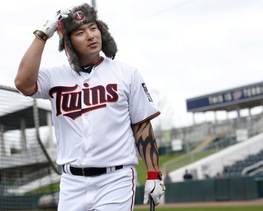FORT MYERS, FLA. – The paranoia of Twins fans and the defensiveness of the Twins’ front office about a past mistake has led us to the most illogical moment in franchise history since Lew Ford ironed his shirt while wearing it.
People are comparing new slugger Byung Ho Park to former failure Tsuyoshi Nishioka. This is like comparing Mickey Mantle and Butch Huskey because they both grew up in Oklahoma.
Park played in Korea. Nishioka played in Japan. Wikipedia indicates that they are not the same country. The Star Tribune is working to confirm.
Park is a first baseman and designated hitter. Nishioka was a middle infielder.
Park is a power hitter. Nishioka was a slap hitter.
Those aren’t even the most important differences between the two.
Nishioka was a diva who insisted on wearing clothes provided by his apparel brand before being forced to change into Twins garb, who alienated many people in his own clubhouse and who wanted to be treated like a star even when he was performing like a minor leaguer.
Park began workouts in Arizona earlier this month. At Twins camp, he initially balked at doing interviews in the Twins’ clubhouse because he didn’t want to draw attention to himself. He conducted a lengthy interview Wednesday, sounding affable, and he has made an effort to converse with teammates.
Most important, there is a large difference in the process the Twins used to choose each player.
The signing of Nishioka proved to be the endgame of a series of decisions that defined and doomed Bill Smith’s reign as Twins general manager. The signing of Park is emblematic of the evaluation process employed by Terry Ryan.
Smith traded Johan Santana to the Mets in a deal that was widely ridiculed at the time. But he did acquire Carlos Gomez in the deal. Gomez did not produce as a Twin and Smith needed a shortstop, so he traded Gomez to the Brewers for J.J. Hardy.
To that point, both deals made some sense. Santana was refusing to re-sign with the Twins, and Gomez was a promising talent. The Twins thought they had a chance to win a World Series in 2010, so they traded that undeveloped talent for a veteran shortstop.
Here’s where things went wrong. Former manager Ron Gardenhire was not a fan of Hardy’s. He wanted a more durable and faster player who could put the ball in play. So Smith traded Hardy to Baltimore for two untalented relievers, and signed Nishioka, who had become a star in Japan.
Nishioka broke his leg in his first week as a Twin. His big-league career never recovered. He became one of the worst players in baseball until agreeing to void the final year of his three-year contract.
The process by which the Twins signed Park was much more thorough and logical. Twins Vice President Mike Radcliff said he and his scouts had been studying Park since he was in high school and always wanted to sign him.
However Park performs, he was not signed on a whim, or as part of an organizational overreaction, or out of desperation.
He hit 53 home runs last year. His former teammate Jung Ho Kang broke in with the Pirates last year and produced an OPS of .816, after posting an OPS of 1.198 the previous season in Korea.
Last year, Park had an OPS of 1.150. If he produces an OPS of better than .800 for the Twins this year, he might become their second-most-effective hitter. Last year the only Twins regular with an OPS higher than Eduardo Escobar’s .754 was Miguel Sano, whose OPS was .916.
The Twins are prepared for Park to start slowly as he adapts to faster fastballs. Oswaldo Arcia will probably make the team as a lefthanded DH and extra outfielder, so the Twins can rest Park against difficult righthanders. “I think Arcia is ready to have a bounce-back year,” Twins Vice President Rob Antony said.
Park might take a while to adapt. He might even fail. Player evaluation is a road pitted with more potholes than Washington Avenue. But there’s no more reason to compare Park to Nishioka than there is to compare Joe Mauer and Dave Winfield because they both grew up in St. Paul.




